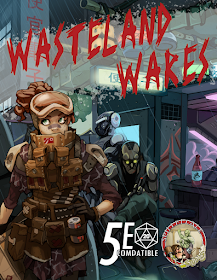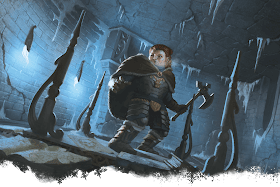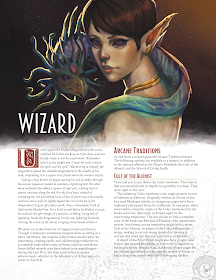This is the second part of a two-part series expanding the Rime of the Frostmaiden campaign by converting other published adventures. This post is aimed at Dungeon Masters looking to add extra material to their Icewind Dale campaign. if you're a player, stream viewer, or podcast listener, you'll find potential spoilers ahead.
The first part of the series provided detailed notes on how to convert the adventure Frozen Sick (found either in The Explorer's Guide to Wildemount or for free on DndBeyond and Roll20). You can find part 1: Frozen Sick here.
Part 2 covers three different adventures. Because they're much more easily adapted, less detail is required for each and it isn't necessary to provide an alternative adventure outline as I did for Frozen Sick. the format for this post will be slightly different, providing general conversion notes rather than an entire adventure outline.
The following adventures are explored in this article:
- Dragon of Icespire Peak. A short campaign included in the D&D Essentials Kit. Specifically, we're interested in the final "boss", a young white dragon named Cryovain, as well as the dungeon in which he lives.
- The Glacial Rift of the Frost Giant Jarl. The second of a trilogy of higher level adventures collectively entitled Against the Giants, which is found in Tales from the Yawning Portal.
- Berg of the Frost Giants. This is an adventure location described in a previous campaign, Storm King's Thunder. It can be used as a substitute for The Glacial Rift of the Frost Giant Jarl, or in conjunction with it.
Dragon of Icespire Peak
It's possible to take content from this Essentials Kit campaign and use it to expand Rime of the Frostmaiden's mid-campaign. While most of the campaign isn’t suitable, the main villain and the final dungeon can be ported into Icewind Dale with only a little bit of effort. The converted adventure is suitable for characters of level 6 or 7.
 |
| (Image copyright Wizards of the Coast) |
Placing the Adventure Site
For the purposes of this adaptation, Icespire Hold needs to be relocated to a position of your choosing somewhere within the Spine of the World.
Introducing the Adventure
Instead of harassing the Sword Coast, Cryovain has recently been preying on the reindeer herds in Icewind Dale. He lairs in a fortress in the Spine of the World, which he recently claimed after driving out the orcs who lived there.
There are many ways you can seed this adventure throughout the campaign, as early as you like:
- Ten-Towners talk about the appearance of the dragon (a number of hunters and trappers have seen it fly by while out in the wilderness and it has become a subject of taproom gossip). They aren’t too concerned by the appearance of another, younger dragon since Cryovain is leaving them alone for now. They assume that it will eventually be driven off by Arveiaturace and the status quo will be restored.
- Reghed tribesmen the characters encounter are more worried about the dragon, since it is causing the herds they rely on for meat, hides, and bone to dwindle.
- If the characters encounter Orcs of the Many-Arrows Tribe in the wilderness, the orcs could be from the clan Cryovain drove out of Icespire Hold.
- They can learn about the dragon while talking with friendly goliaths from either tribe. The goliaths are not only aware of the dragon, they are searching for its lair.
- They can see the dragon themselves while travelling in or near the mountains, or it could plunge from the sky into the middle of a reindeer herd they encounter in the wilderness.
None of the factions above recommend the player characters go dragon hunting unless they believe the party are extremely competent (eg. not until they are of appropriate level!). Friendly and Indifferent NPCs do their best to put characters off from any such attempt.
Matters become more urgent after the chardalyn dragon rampages through Ten-Towns in chapter 4. By this time the player characters should be level 6 to 7, and equipped to take on Cryovain at Icespire Hold. With the settlements weakened, Cryovain becomes more daring. He begins preying on yaks, axe beaks, sled dogs, and other domesticated beasts, and even the occasional traveller. Perhaps the dragon even attacks the party on their travels, in which case it retreats after losing 10 hit points in battle as described under “Where’s the White Dragon?”. Surviving Speakers ask for the help of their local heroes, hoping they will slay another dragon to save Ten-Towns. If the party already know that the Reghed tribes are concerned by the same issue they might be able to negotiate multiple rewards from each faction.
Finding Cryovain
Talking to people who have seen Cryovain in action confirms he typically flies towards the Spine of the World after an attack. The Spine of the World is a very large place, of course. This would be a good time for the party to visit a friendly goliath tribe, since the mountain-dwellers might have more of an idea where to find the dragon. A town Speaker or NPC ally might suggest this if the players don’t consider it themselves.
- If the party visit Skytower Shelter, the goliaths of the Akannathi tribe are well aware of the new dragon and have been keeping an eye on his movements from atop their griffons.
- If the party visit Wyrmdoom Crag, the goliaths of the Thuunlakalaga have a history with white dragons and so were both concerned and excited at the prospect of another dragon to fight. Their scouts have ranged across the mountains in search of the lair.
Either way, the chosen tribe can give precise directions to Icespire Hold. If the tribe and the characters have friendly relations, they may be able to persuade some goliath warriors to go on the quest to kill Cryovain at your discretion.
Icespire Hold
In the recent past orcs of the Many-Arrows tribe made their lair in this crumbling fortress. They were driven out by Cryovain. Run the dungeon as is.
Against the Giants
A set of three adventures published in Tales from the Yawning Portal, one of which makes an excellent addition to Rime of the Frostmaiden. Specifically: The Glacial Rift of the Frost Giant Jarl. The adventure is intended for level 12 characters, making it a perfect follow-up to the campaign proper.
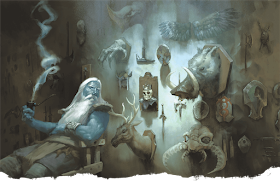 |
| (Image copyright Wizards of the Coast) |
Incorporating the Plot
Treat the frost giant Jarl Grugnur as the current Jarl of Jarls. All frost giants therefore owe him their fealty. The frost giants are beginning to become more active, perhaps emboldened by Auril’s permanent winter. There are a few possibilities as to why:
Use Against the Giants as is
One option is to leave the larger plot of Against the Giants intact, in which case the activity of the frost giants is part of a larger scheme involving other types of giants and spearheaded by drow. Even so, you might want to skip the hill giant adventure since it's intended for lower level PCs (though you could make some adjustments), instead having your PCs move straight on to the fire giants. If you need an idea for where to take your players next, the drow ringleaders provide a possibility: if your players want to know why the drow needed the giants to soften up the surface world, they'll have to venture into the underdark to find out!
There is no alliance of giants
Perhaps the frost giants are acting independently. Jarl Grugnur is in fact amassing an army of giants, ready to rampage across Icewind Dale and conquer it. The region would then become a staging ground for the frost giants to build a larger empire across the Sword Coast, freezing the conquered lands as they go.
The drow can still be behind this if you like, in which case you can consider taking the drow which normally appear in the Hall of the Giant King and re-home them in The Glacial Rift of the Frost Giant Jarl. You could empty out the guest bedrooms (currently occupied by giants of other types) to make room for the drow party.
Jarl Grugnur is being tricked by Asmodeus
As above, but Asmodeus is behind the giants' plans for conquest. He appeared to the Jarl in the guise of Thrym, god of frost giants. This mirrors the true story behind Xardorok and the duergar in Rime of the Frostmaiden. This connection suggests both events are part of a larger scheme of the Archdevil, and can be used to draw your players into a new infernal-themed campaign arc.
Placing the Adventure Site
The stronghold of Grugnur, Lord of Frost Giants, should be hidden away amid the tallest peaks of the Spine of the World.
Introducing the Adventure
You can seed this adventure early by suggesting the presence of a larger frost giant settlement and a change in frost giant movements within the region.
- Ten-Towners and Reghed tribesfolk might note in conversation that wilderness encounters with or sightings of frost giants seem to be on the rise. From Chapter 5 onward, gossip about this begins to escalate because encounters grow more frequent still. You might consider adapting the wilderness encounter table to add a few additional frost giant encounters.
- Frost giants encountered in the wilderness might shout “For Jarl Grugnur!” in the giant tongue as they charge into battle. A giant among their number could be carrying written orders from Jarl Grugnur.
- While completing the quest “Holed Up” (see “Dougan’s Hole”), the party might find a giant-sized seal leather scroll case near Garagai’s bedroll. Inside is a missive from Estia, Jarl Grugnur’s wife. In years past Garagai had been a rival for Estia’s affection until he was driven out by Grugnur when he became Jarl of the Glacial Rift. Estia wrote one last letter of farewell to him, which he treasured until his death.
- Verbeegs encountered during the adventure could have received an invitation from the Jarl to join with his forces, promising any giantkin who does so glory and wealth in the days to come.
- The characters might find a giant-sized scroll case in Duhg’s treasure basket (found in the chapter 1 adventure “The Mead Must Flow”). Inside is a letter from the Jarl effect written in giant runes. Gahg, Dugh’s paramour, received a similar invitation, though the characters are unlikely to learn that.
- Tinjong (see “Dark Duchess” in chapter 2) received an invitation too. The party might learn about it through conversation if they travel with her for a while. Tinjong no longer has the letter, which she long since used for kindling, but she kept the giant-sized seal leather scroll case and tied it to her belt to use as storage for sling stones. Characters who have seen similar scroll cases might reason she received a letter from the frost giants.
The events of Rime of the Frostmaiden ought to keep player characters too occupied to seriously consider seeking out the giants before resolving the campaign, but just in case friendly NPCs can caution that even a single frost giant is a dangerous foe. An encounter with one in the wilderness can do a lot to reinforce that threat. When the characters have overcome a goddess, however, they may feel more ready to take on the giants.
Ready or not, the giants begin to move and a war party raids Ten-Towns. Unlike with the chardalyn dragon, have this event occur while the characters are already in the vicinity and able to take part in the defense.
After this attack it becomes obvious that the frost giants are a threat that needs dealing with. The Speakers can ask for help if necessary. They don’t have much in the way of a reward, since any wealth Ten-Towns still has is tied up in rebuilding. A reminder of the treasures the frost giants likely have in their fortress should hopefully be enough. One or two of the giants who attack Ten-Towns could carry magic items to help support this idea.
Finding the Glacial Rift
Once it’s decided to hunt down the frost giants, finding them isn’t actually that difficult. By now the characters might have magic that will help them locate the stronghold, but if not they really only have to follow the trail of the frost giant war party back into the mountains.
The Frost Giant Stronghold
Run the adventure as is, subject to any changes you deem fit. If the frost giants aren’t part of a larger plot among the giants, then the teleporting bar in the hidden escape tunnel may not exist or may have an entirely different destination. One possibility is it could transport anyone in the alcove to the Svardborg, the Berg of the Frost Giants (a location in Storm King’s Thunder, see below!).
Storm King's Thunder
Svardborg, the Berg of the Frost Giants, is one of several locations described in the Storm King’s Thunder campaign.
If you don’t have access to Against the Giants, you could adapt the idea that the frost giants are amassing their forces for conquest (see the conversion notes for Against the Giants, above) and simply use Svardborg as an alternative base of operations for in place of the Glacial Rift. Likewise, Jarl Storvald can take Grugnur’s place as Jarl of Jarls.
If you have access to both Against the Giants and Storm King’s Thunder, then the frost giants of Svardborg are allies of Jarl of Jarls Grugnur. The party might visit the Svardborg before or after they go to the Glacial Rift.
Either way, since Svardborg is intended for a party of 8th level characters it fits less easily into the narrative of Rime of the Frost Maiden as written, and I’d suggest beefing this adventure site up a bit to make it an appropriate challenge for a 12th level party.
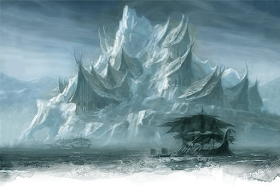 |
| (Image copyright Wizards of the Coast) |
Placing the Adventure Site
Svardborg is already located out on the Sea of Moving Ice, which means it can easily be used as a location in Rime of the Frost Maiden.
Introducing the Adventure
The details under Against the Giants apply here too, whether you’re using this adventure site to complement The Glacial Rift of the Frost Giant Jarl or in place of it.
Frost giant war parties descend on Ten-Towns from the direction of the Sea of Moving Ice as well as the Spine of the World. The two groups consolidate their forces before beginning their raid. Ten-Towns scouts report that the war party from the North is smaller, which causes the town’s Speakers and military leaders to speculate that any camp or stronghold in that direction is smaller and weaker. They suggest the party head that way first, but leave the decision up to the characters.
Finding Svardborg
The awakened sperm whale Angajuk knows the location of the frost giant stronghold and can take characters there. He normally tries to avoid it as the giants roam the waters around the village in their ships, hunting whales, but he will brave the journey for characters who have earned his trust once they impress upon him that their need is great.
If the party goes to the Glacial Rift first they may be able to teleport directly to the island from that location.
Svardborg
Run the adventure as is except as otherwise noted here, even the part about the Zhentarim alliance and the Ring of Winter. Jarl Storvald is looking for the ring independently of Jarl Grugnur’s plans. Storvald wants to find the ring and use it to overthrow Grugnur and claim the title of Jarl of Jarls.
If the zhentarim scouts and manticores are defeated before they can rescue Nilraun from danger, he’ll try to trade information for his life (giving up as little as he thinks he can get away with, of course). If he learns the party are from Icewind Dale, he offers to tell them the name of an important Zhentarim spy in the region provided they let him go and never reveal he was their source. If the characters agree to this deal Nilraun exposes Speaker Naerth Maxildanarr of Targos, finally revealing his treachery.
Returning from Svardborg
If the party arrived by boat or with Agajuk’s help they may already have a way home. If not, there’s one option available to them:
The conch of teleportation found in this adventure doesn’t teleport creatures to Maelstrom. Instead, choose one of the following locations in Icewind Dale:
- In front of the passage to the Glacial Rift (from The Glacial Rift of the Frost Giant Jarl).
- The Jarlmoot.
Cryovain II: The Recycling
It seems that Wizards of the Coast reused the white dragon Cryovain, first using the name for an adult dragon in this adventure and then again as a young dragon in Dragon of Icespire Peak. If you decide to use both adventures in your expanded Rime of the Frostmaiden campaign then one of the two dragons needs to be renamed. It doesn’t really matter which!



